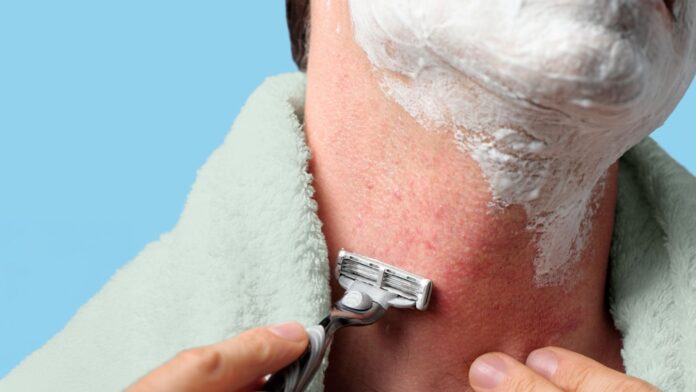Most people have had the unpleasant experience of razor burn at some point in their lives. Razor burn is skin irritation that occurs while shaving your face, legs, or other body parts to remove unwanted hair. The interaction between the blade, hair, and skin is what causes razor burn. Razor burn occurs in both men and women, and it can last anywhere from a few hours to a few days, depending on how severe it is. People with sensitive skin may be more susceptible to razor burn.
Signs and Symptoms of Razor Burn Symptoms Symptoms of razor burn may include: Red bumps A rash Stinging Most likely, it will look like red, irritated patches of skin.
Causes and Risk Factors of Razor Burn Causes “Razor burn is caused by trauma from your razor blade while shaving,” says Joshua Zeichner, MD , an associate professor of dermatology and the director of cosmetic and clinical research at Mount Sinai Hospital in New York City. “As the razor blades move over the skin, they can disrupt the outer skin layer, leading to microscopic cracks, loss of hydration, and inflammation.” This translates to the red, itchy rash you may experience. Not using shaving cream or gel, or other products with emollients, may also lead to razor burn. Emollients layer the skin with a protective film that traps in moisture and prevents inflammation.e60dc2a1-f33c-4a05-9b50-8e3e8e59762993deeefe-b109-40e2-bb9e-48e685ed0060
How Is Razor Burn Diagnosed? Diagnosis If you experience an uncomfortable, red rash after shaving that doesn’t go away on its own, see a dermatologist who can determine if you have razor burn. “Razor burn is a clinical diagnosis based on the location of the rash, history of prior shaving, and characteristic red, irritated patches of skin,” explains Dr. Zeichner.
Duration of Razor Burn Duration Razor burn can last anywhere from hours to days depending on how severe it is, says Zeichner. To speed up healing, stop shaving until your symptoms dissipate.
Treatment and Medication Options for Razor Burn Treatment When it comes to treating razor burn, you have a few options, says Zeichner. You can: Apply gentle moisturizers to hydrate and repair the skin barrier. Use an over-the-counter 1 percent hydrocortisone cream to reduce inflammation. It can be used twice daily for one to two weeks. If your razor burn doesn’t improve in a few weeks, visit a board-certified dermatologist, who can evaluate your skin and recommend a proper course of treatment.
Prevention of Razor Burn Proper shaving technique can minimize your chances of developing razor burn. Here’s how to get a smooth, irritation-free shave:e60dc2a1-f33c-4a05-9b50-8e3e8e59762960d512de-6126-47e0-8a21-b3f11be16d1a Moisten skin first. The best time to shave is after a warm shower while your skin and hair are soft and moist. Apply shave cream or gel. This will create a barrier between the blade and your skin and enhance the glide of the razor. Use single strokes, in the direction of hair growth. Do not go over the same area multiple times, and do not go against the grain. You may think that shaving in the opposite direction of hair growth provides a closer shave but it actually leads to irritation. Rinse the razor frequently. Clean the razor every two to three strokes to remove debris that builds up between the blades. Do not tap the blades against the sink because this can disrupt the specialized polymer coating that is used on most razor blades. Moisturize. Apply a moisturizing aftershave lotion to help hydrate and repair the skin barrier. Be sure to store your razor in a dry place to prevent bacteria growth. Dermatologists suggest replacing a razor blade after five to seven uses.e60dc2a1-f33c-4a05-9b50-8e3e8e597629b34d8fa1-ac99-4865-ae74-91c72047375d
Complications of Razor Burn Complications Razor bumps — also known as pseudofolliculitis barbae — can occur in conjunction with razor burn or on its own. Unlike razor burn, which is skin irritation, “razor bumps are ingrown hairs that lead to red bumps and pus pimples,” says Zeichner. “The hair turns back into the skin rather than growing out as it should.” Pseudofolliculitis barbae is a form of the broader skin condition known as folliculitis . If you are prone to folliculitis, an antibacterial face wash can help prevent razor burn. Razor bumps are especially common in people with curly hair. To prevent razor bumps, follow the proper shaving technique described above. The best way to treat razor bumps is by stopping shaving. If your razor bumps are severe, you can treat them with creams that contain hydrocortisone or tretinoin under supervision by your primary care doctor or dermatologist.e60dc2a1-f33c-4a05-9b50-8e3e8e59762922e886eb-0a12-46b0-9ae2-12b8e42c3578
Research and Statistics: Who Has Razor Burn? Research and Statistics Although there are no statistics regarding how many people experience razor burn, Zeichner says it’s “a very common condition that I see on a daily basis in my practice.”
Black Americans and Razor Burn Black Americans Razor bumps in particular may be more common in men of subequatorial African descent, with a prevalence as high as 83 percent.e60dc2a1-f33c-4a05-9b50-8e3e8e597629e256139e-6f07-4f91-97de-437b6bfa6e17
Related Conditions and Causes of Razor Burn Related Conditions If you have acne, you may be more susceptible to razor burn; and shaving, which can irritate your skin, can also worsen your acne. To minimize irritation, use a razor with a sharp blade or try using an electric razor. Use light strokes to prevent nicks, and don’t try to shave off pimples (that too can make your acne worse).e60dc2a1-f33c-4a05-9b50-8e3e8e597629e4b11890-3e14-4ca5-9cd6-c82d8c11184a
Resources We Trust Mayo Clinic: Mayo Clinic Minute: Shaving Too Close Can Cause Skin ProblemsCleveland Clinic: Razor BurnAmerican Academy of Dermatology: Hair Removal: How to ShaveUniversity of Michigan Health: Razor BumpsAmerican Osteopathic College of Dermatology: Pseudofolliculitis Barbae

